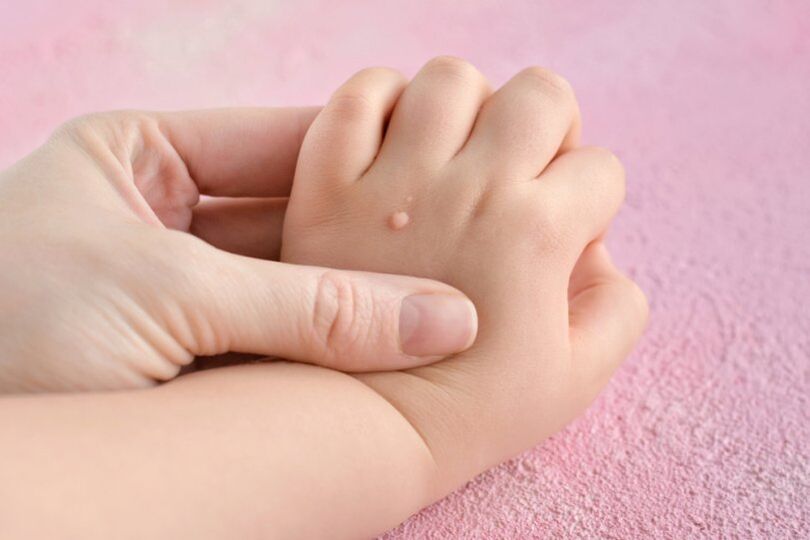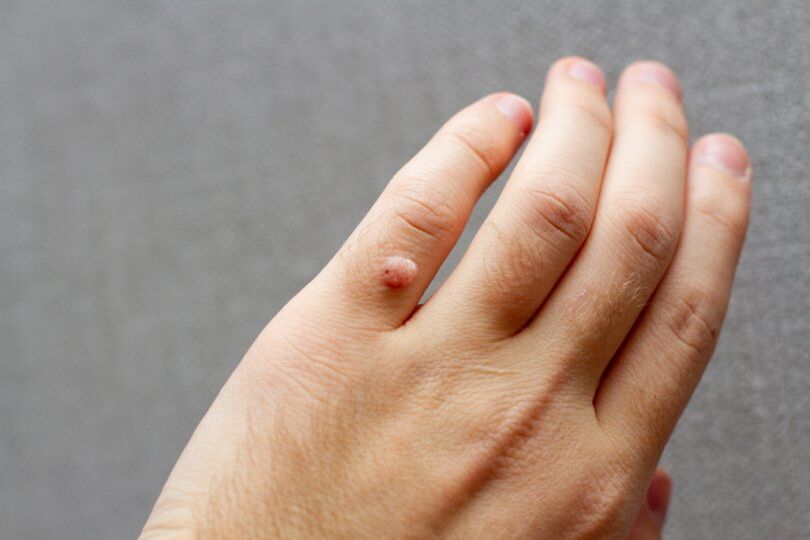A wart is a benign formation on the skin that looks like a rounded bump, the cause of which is profuse growth of the surface epithelium and papillary layer.
In most cases, cell proliferation is caused by HPV, provoked by external and internal factors - restlessness, a drop in immunity, in some types - increased sweating of the extremities. You can become infected with HPV through contact with a carrier and objects. This does not apply to age warts - their formation is not viral in nature.



The size of the formations varies on average from 1 to 15 mm (senile reach 6 cm). They have an uneven surface and are therefore easy to get dirty. Because of this, they can change color from almost flesh to brown over time. Multiple units can group together when in close proximity. All warts can be removed. In some cases, the doctor may choose to observe without removing if the patient is comfortable.
When you urgently need to see a doctor:
- Education is located in the genital area;
- in the area of the neoplasm, itching, discharge is observed;
- there is a heterogeneous color, spots;
- it changes shape and color;
- because of the situation is injured in everyday life;
- Not sure if it's a wart.
types of warts
There are 4 types:
- ordinary (simple) - formed on the hands (subgroup inside - plantar);
- flat - appear mainly in young people, so the second name of flat warts is juvenile;
- pointed - formed in the genital area, infection with HPV types that cause it;
- senile - the causes are unclear, are not caused by HPV, are formed in middle-aged and older people.
Common warts are 1-10 mm in size, dense, calloused. The average lifespan of such a formation is about 2 years, after which it spontaneously dissolves. The most common localization site is the brushes.
Plantar warts are growths on the feet that initially appear as a small callus, then a rough surface with black dots appears in the center and a small roll around the edge. Horny formations cause inconvenience, as the patient feels pain when walking. They can lead to loss of mobility and performance. Plantar wart removal greatly improves the quality of life.
Flat warts have distinct edges, are small - up to 5 mm, and slightly rise above the surface of the skin by 1-2 mm. Any shape - round or uneven. Skin irritations, scratches, cuts can cause the appearance. Favored locations for locating such formations are the face, hands, and shins.
Genital warts are located on the genitals. They are dealt with by removal, and fairly quickly as they can grow to large sizes. Infection occurs sexually, its probability is higher in the presence of wounds in the groin. Condylomas are pink nodules that fuse to form papillary growths attached to a stalk on the body.
Senile warts (seborrheic keratosis) are the only warts listed that are not related to HPV. Due to the often positive family history, one can speak of a genetic predisposition. Formations can reach rather large sizes - up to 4-6 cm (average size - 0. 2-3 cm). They appear in a group of up to 20 units. The most common places of localization are the chest, face, neck, forearms, hands.
First of all, the elements are flat and small, the surface is uneven. They are covered with crusts that are easily removed. Then the crusts become denser, drier and covered with cracks. Over time, their thickness can be 1-2 cm. With age, they take the shape of a mushroom cap and become dark, although originally they were light yellow or pink. They contain impurities. Formations never turn into a craboid shape.
removal of warts
Wart treatment is selected by the doctor individually, depending on its type, size, contraindications and other aspects. The clinic offers 4 ways to remove warts, papillomas and condylomas:
- with a radio wave scalpel;
- Laser removal of CO2;
- cryo destruction;
- diathermocoagulation.
They are suitable for removing flat and raised warts. Unfortunately, none of the presented methods are able to eliminate HPV from the body, leaving the probability of recurrence at 30%. Also, no method is 100% guaranteed, an additional procedure may be required. Scars may remain after removal, the right choice of clinic and technique will help to avoid this. Experienced dermatologists in a professional clinic and high-quality equipment manufactured according to modern standards are a combination that provides quality service, freedom from pain and speedy recovery. Infiltration and application anesthesia are available.
laser removal
The laser generates a powerful energy light flux that causes a sharp increase in temperature in the tissue. The advantages of removing papillomas and warts with a laser are the absence of bleeding, blisters and large scars. The process takes 5-7 minutes. As a rule, formations are eliminated the first time.
Removal of warts is carried out according to the following plan:
- skin treatment with an antiseptic;
- Treatment with an anesthetic (injection or lubrication);
- treatment of papillomas over the entire surface;
- Treatment of the resulting wound and bandage.
cryo destruction
The treatment is carried out with liquid nitrogen. This procedure is used in the removal of a variety of neoplasms, and even in the treatment of tumors of internal organs, diseases of the cervix, liver surgery. Under the influence of low temperatures, the water in the cells freezes, the cell bursts and dies.
Removal Procedure:
- anesthesia (if it is large, it is in an area with thin skin);
- Exposure to a cotton swab soaked in liquid nitrogen (5-30 seconds depending on size);
- wait 2 minutes. Investigation. If necessary, repeat the process.
The next day, a blister appears on the skin, which gradually passes. The task of the patient is not to damage the bladder prematurely, wash it carefully, do not apply a plaster, protect it from external influences.
diathermocoagulation
This method of treatment involves cauterization of tissues using a high-frequency current, a contact and non-contact method. The procedure is performed with the help of EKhVCh (High Frequency Electrosurgical Device). The difference from the radio wave scalpel "Surgitron" lies in the use of high-frequency current - about 400 kHz (up to 4 MHz in the radio knife). The method allows bloodless coagulation of the skin and effective management of formations.
Radio Wave Scalpel
As a radio wave scalpel, when removing warts, Surgitron is used, which works on radio waves with a frequency of 3. 8-4. 0 MHz. The wave vaporizes the cells it is aimed at and does not affect the neighboring ones. Because of its delicacy, this method is commonly used on the face, neck, and genitals. Also among the advantages are high speed, bloodlessness, minimal swelling, rapid healing.
The operation is performed as follows:
- the skin is treated with an antiseptic;
- Anesthesia is administered (injections, cream);
- the doctor takes the waveguide of the desired shape and removes the neoplasm;
- antiseptic treatment.
Make an appointment with a dermatologist
The network of NEARMEDIC clinics offers several effective methods of removing flat, pointed, senile, common, including plantar warts. An inexperienced person can confuse warts with other neoplasms that can turn into a malignant form - before treatment, it is necessary to consult a dermatologist.
Experienced dermatovenereologists, candidates and doctors of medical science treat in our clinic, with whom you can consult even in difficult cases. On the website you will find the names, photos and biographies of all specialists with their place of registration. Here you can make an appointment with a specific doctor.
Removing the visible manifestations of the problem is not enough to reduce the likelihood of relapses. For this, general therapy with antiviral drugs that reduce the activity of the human papillomavirus is used. The doctor conducts a full diagnosis, develops a treatment plan, advises on all types of removal and recommends the most effective in a particular case. At the first signs of the disease, contact a specialist.
The cost of a doctor's appointment and removal are given in the table. Please note that removing 2 to 5 or more than 5 formations is cheaper. To make an appointment, please call or use the form on the website.














































































